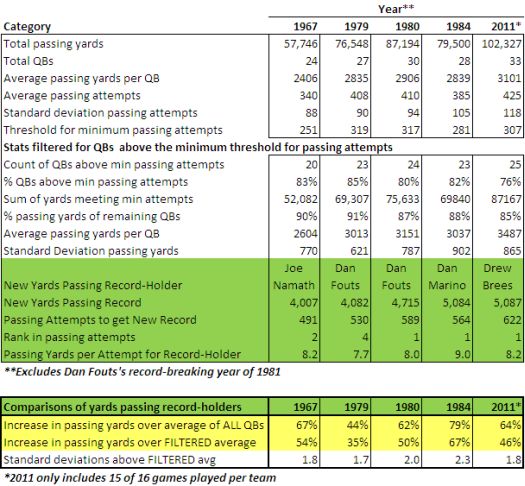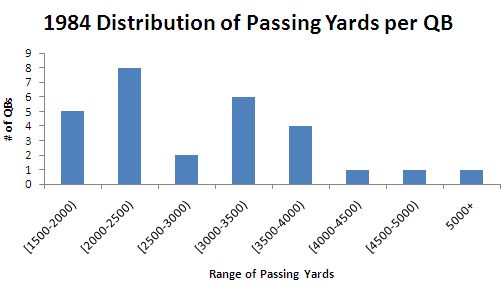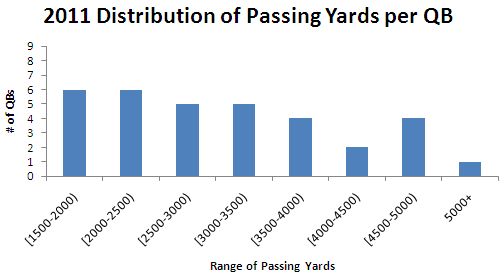In this post, I take a detour from the analysis of financial markets to another passion of mine, professional football! The analytical lesson here is that context and relative comparisons are always important to understand the true significance of performance. Moreover, trying hard is a sufficient criteria for success, but trying a LOT is likely a necessary condition. The better you are (the more profits you gain), the more likely you will get the opportunities for greater success…
— + —
Congratulations to Drew Brees for breaking Dan Marino’s NFL record for passing yards in a season. With one game left to play this season, Brees surpassed Marino by throwing a late touchdown to running back Darren Sproles that only had meaning because of the record. I have read and heard some gripes about how Marino’s record was broken. The most interesting complaint is that Brees’s record deserves a footnote because NFL rule changes have made it much easier for quarterbacks to throw and for receivers to catch.
There are many ways to attempt to correct for such a mismatch in context. Normalizing statistics relative to the quarterbacks playing under the same rules is probably the most direct method to account for differences. Indeed, at the end of the Saints record-breaking game against the Atlanta Falcons, I thought I heard ESPN commentator Mike Tirico reassure everyone that Drew Brees still outshines Dan Marino when comparing each QB to the average quarterback in their respective record-breaking seasons. However, when I checked the statistics, Marino actually still stands above Brees. In fact, he stands above all the record-breaking quarterbacks of the “Super Bowl era” (in passing yards).
In the chart below, I use player statistics from NFL.com to compare the record-holders in passing yards to that of the average quarterback of that same season. I calculate this increase using all quarterbacks and additionally a list of quarterbacks filtered by a threshold for a minimum number of passing attempts. The threshold removes most QBs who had almost no chance of setting the record because of a lack of opportunities (whether because of injury, demotion, or even a run-dominated offensive game plan). See the areas in green and yellow. I explain the rest of the table next.

Source: data from NFL.com statistics and list of record-holders from ESPN.
Not only does this chart show that Dan Marino was much further above the average quarterback in the same record-breaking season than any other record-holder, but it also shows that Dan Fouts truly ushered in the new era of the profligate passer. When he broke is own record in 1980 with a near 20% increase in passing yards, the average QB’s passing yards only increased by around 3%! (Note that this average performance has definitely spiked higher these days.)
With such a rapid and sudden increase in production (NOT productivity), I find it VERY surprising that Marino broke Fouts’s record in just four years. Note that in 1978, the NFL went to a 16-game schedule from a 14-game schedule. Joe Namath’s passing yards per attempt are almost exactly the same as Fouts and Brees. Here again, Marino stands above the other record-holders with 9 yards per passing attempt.
The graphs below show a definite difference in the pool of QBs from 1984 to 2011. In 1984, there were only two QBs who were anywhere close to Marino with over 4000 years. This season, there are SIX QBs in this category trailing Brees. Moreover, the performance of the remaining QBs is very even across the categories of passing yards. In 1984, the remaining distribution was quite lumpy with a large cluster of under-performers.


Source of data: NFL.com statistics for 1984 and 2011
*QBs must have at least 14 passing attempts per game. 2011 covers the first 15 games of the season played by each team.
(For you fantasy football players, the differences shown above mean that it is easier to wait until later draft rounds to pick up a QB than in Marino’s day if you cannot score a top-tier QB!)
I do not interpret any of these results as fodder for diminishing Brees’s accomplishment. There are many things that support a QB’s stats including a strong offensive line, extremely skilled wide receivers, and even playing in a division (or conference) fielding
relatively poor secondaries. It is very hard, indeed near pointless, to account for all the factors that explain how a record gets broken. It is also much less fun to read about records that contain a paragraph full of caveats and footnotes.
Commentators like Jason Cole of Yahoo!Sports have griped that Brees broke the record in an unclassy way. At a point in the game when teams focus on running out the clock with conservative running plays, the Saints focused on getting Brees to break the record by passing the ball. I do not blame coach Sean Payton or Brees for doing this. Getting the record on Monday Night football in front of an excited home crowd is a very electric and exciting way to get it done. It is a fantastic combination for us fans of the game. Besides, as linebacker Sean Weatherspoon was quoted in Coles’s article (Weatherspoon was supposed to cover Sproles), the Falcons still have to play defense no matter the score:
“No man, it’s our job to stop them…I can’t say I’m upset by them running up the score or anything like that when I had a chance to make a play.”
Congrats to Brees. Marino, you are of course still a giant amongst QBs.
I cannot wait to see the Falcons try to exact revenge on Brees and the Saints. Bruised egos and exultant victors make the competition even more intense.
Be careful out there! (And Go Raiders!)
Full explanation of the statistics categories:
- Total passing yards: sum of passing yards of ALL QBs who passed for at least 14 times per game.
- Total QBs: sum of all quarterbacks who registered on the NFL stats list for at least 14 times per game.
- Average passing yards per QB: total passing yards divided by total QBs.
- Average passing attempts: total passing attempts per included QB for the given season.
- Standard deviation passing attempts: measure of the width of the distribution of passing yards per QB. The larger the standard the deviation, the larger the disparity in performance from the average number of passing attempts.
- Threshold for minimum passing attempts: Standard deviation passing attempts subtracted from the average passing attempts. This provides an approximate measure used to filter out QBs who had insufficient attempts per game to be considered a “peer” of the top QB.
- Stats filtered for QBs above the minimum threshold for passing attempts: the statistics in this group are the same as above but only include those QBs whose passing attempts exceeded the calculated minimum threshold. The listed percentages indicate how many passing yards and QBs still remain in the pool after filtering.
- New Yards Passing Record-Holder: Name of the QB with the record for passing yards as of the given year.
- New Yards Passing Record: the record for passing yards as of the given year.
- Passing Attempts to get New Record: the passing attempts of the record holder.
- Rank in passing attempts: where the record holder ranks relative to other QBs in passing attempts.
- Passing Yards per Attempt for Record-Holder: total passing yards divided by passing attempts for the record-holding QB.
- Increase in passing yards over average of ALL QBs: the record-holder’s percentage increase over the average passing yards for all QBs with at least 14 passes per game.
- Increase in passing yards over FILTERED average: the record-holder’s percentage increase over the average passing yards for QBs who exceeded the threshold calculated above.
- Standard deviations above FILTERED avg: Total passing yards divided by the filtered standard deviation calculated above (note this is calculated only for comparison purposes. There are more accurate ways of accounting for these distributions, especially given the passing yard statistics are not normally distributed).
Video Links
QB Brees to RB Sproles, 9-yd, pass, TD
Saints’ sentimental moment – Payton and Brees speak to team in the locker room
Brees breaks Marino’s record (NFL Total Access coverage)
*Addendum
12/28/2011: Corrected chart of QB comparisons. Original contained error in calculation of standard deviation of (filtered) passing yards.

Rule changes have inflated passing yards an average of only 28 yards per game. Brees record-breaking year represented a greater increase over the average QB for this era (SD=2.3) than Marino’s great accomplishment releative to the average QB in 1984 (SD=2.27). Of course, Brees essentially reached this milestone twice in three years. Congratulations to both historic QBs. Brees has demonstrated a greater ability to gain passing yards than any other QB in NFL history.
Where are you getting the averages and standard deviations from? Seems like you are including ALL QBs rather than filtering out QBs with low participation rates?